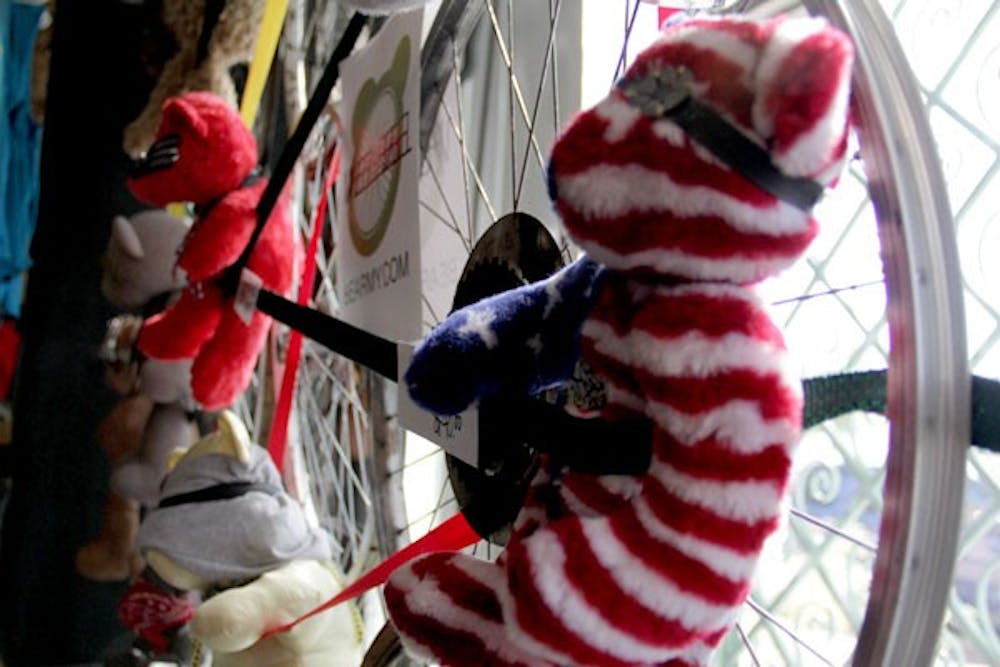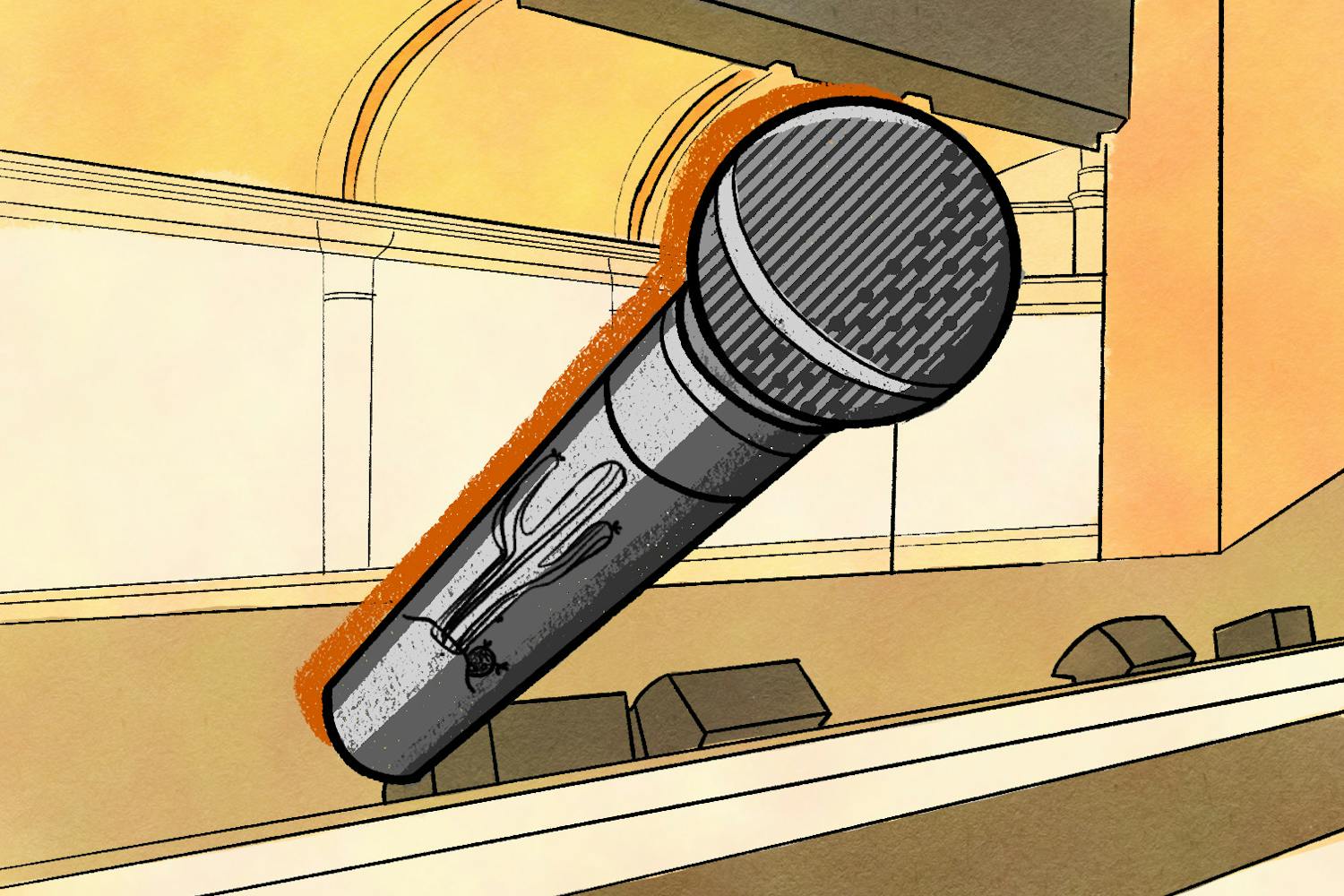 Featured at the Lab Pop-Up Gallery near downtown Phoenix, the rescued and reconstructed teddy bears are part of the DIE Bearmy art project, which uses the once abandoned bear to help send a message about the importance of recycling. (Photo by Shawn Raymundo)
Featured at the Lab Pop-Up Gallery near downtown Phoenix, the rescued and reconstructed teddy bears are part of the DIE Bearmy art project, which uses the once abandoned bear to help send a message about the importance of recycling. (Photo by Shawn Raymundo)At DIE bearmy’s two-day display inside 11th Monk3y Industries' new location on Grand Avenue, unofficial doctor Tara Logsdon cuts tags for her hanging army of teddy bears — a cluster of cute, colorful misfits dangling from bike wheel spokes. Longsdon calls it “Wheel Bearel,” adapting her set to the shop’s unique vibe.
Logsdon “rescued” each bear from a thrift shop before she performed surgery – amputating button eyes or noses and sewing patches, blindfolds or belt buckles in their place.
Each of Logsdon's patients has a unique name to go with a new identity. There’s Moccasin, a tan corduroy bear adorned with an embroidered dream catcher and Tonto, given a Louis Vuitton heart transplant and a new bandana to mask his face.
“This (bear) is something that no one wanted. It ended up face-down in a thrift store covered in that awful cinnamon air freshener smell, and now it’s being displayed like a piece of art in a gallery with a spotlight on it,” Logsdon said. “It's all context.”
The artist adorns DIE bearmy patients with material from designer clothes and accessories to symbolize the bears' newly acquired value. She removes noses and replaces eyes so each bear has a blank slate.
Logsdon takes her work as a bear surgeon very seriously, and the misfit toys are showcased in similarly serious ways. DIE bearmy’s website details the diagnosis, necessary treatment and rehabilitation program that rescued bears undergo before they re-enter the world. Her unusual title has landed mentions of her work in the Huffington Post, LA Times and Wall Street Journal.
“When I was a little kid I was obsessed with being a doctor,” Logsdon said.“I would do surgeries and had all these stuffed animals that I worked on. … My parents probably thought I was going to be a real doctor, but I actually just turned out to be a stuffed animal surgeon.”
Logsdon began to notice how many bears had been abandoned at thrift stores and garage sales when she moved to Phoenix.
“There was a bear there that someone had taken all the time to make, but they didn’t put eyes or anything on it. It was just blank," Longsdon said.
That’s when she began adopting the rescued bears. She cut patches from Gucci purses and sewed them onto the bears’ chests. Through vision questing and surgery, her patients received a full sensory makeover and re-emerged for adoption.
Beyond DIE bearmy’s proclamation to repair “dismembered souls and appendages,” Logdson said the displays serve as a platform for a stronger message about abandonment in today’s consumer culture.
“It’s kind of indicative of our entire condition," Logsdon said. "We have enough stuff in the world, we don’t need to keep making more. When people buy stuff, they need to really think about what they’re doing. I’m just really anti-abandonment.”
In September, Logsdon washed, stitched and sold recovered bears in a pop-up gallery on Roosevelt Street she named the Urgent Bear Center. Every adoptee met with Logsdon for a surgical consultation. Bears were given patterned blindfolds, eye patches or bandanas before re-entering the world as DIE bearmy soldiers.
“Eighty percent of our culture is consuming stuff,” Logsdon said.
According to its website, DIE bearmy combats mass production and consumption to “bring awareness to the desertion of living and inanimate things.”
Jess Dann, an exploratory sophomore at ASU, was one of three volunteers at Dr. Logsdon’s Urgent Bear Center. At the exhibit’s entrance, she introduced visitors to DIE bearmy’s message, which promotes deliberate use and recycling.
“It was cool to see little kids and parents supporting something that’s sustainable and something that uses 100 percent recycled materials,” Dann said.
Dann said the project raises awareness of a problematic culture that centers on consumerism but undermines reducing, reusing and recycling.
But like many Phoenix residents, Dann said she doesn't recycle because a curbside recycle pickup service isn't readily available to her.
"I’m guilty of it, too," Dann said. "I don’t recycle, because no one comes and picks up my recycling."
DIE bearmy asks the consumer to be more calculated with both creation and consumption.
“It’s like an eco-friendly Build-A-Bear,” said criminology sophomore Esther Oh, another Urgent Bear Army volunteer.
Logsdon said that a fair amount of the bears she rescues are actually from the high-end custom teddy bear retailer, a fact that angers her. Regardless of any bear's starting point, it is not necessarily safe from a fated thrift store future.
“Even though these bears aren’t alive … most of them contain fibers that will live 450 to 1,000 years,” Logsdon said. "I'm trying to raise that awareness of like, ‘OK, what am I buying? Do I really need to buy this thing that’s going to outlive me by 47 generations?’”
Logsdon’s grandmother, a master embroider and seamstress who often donated to charity, inspired DIE bearmy’s message. The project is even named after her grandmother’s monogrammed initials, D.I.E.
“She inspired that whole feeling in me to live moderately, to live within your means, to not be excessive, consume or waste,” Logsdon said.
DIE bearmy donates 10 percent of profits to SOS Children’s Villages, a charity that cares for orphans and abandoned children in 123 countries around the world.
Logsdon feels abandonment is a common theme in American culture, and DIE bearmy aims to combat it, one rescued bear at a time.
She said that here, when people are mentally ill or old, they tend to be abandoned.
"In other cultures, you don’t see mentally ill people wandering around," Logsdon said. "If that’s somebody’s brother or somebody’s son, they take care of them. We have this whole mindset here that if it doesn’t fit into our busy schedule then we just cast it away and it will be fine and it will take care of itself, which we all know is not true."
Reach the reporter at aovnicek@asu.edu or follow her on Twitter @aovnicek




